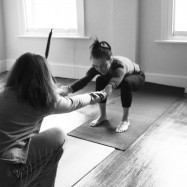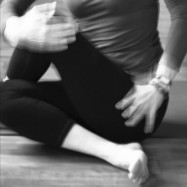Somatic Movement: What is movement that is Authentic
Mary Starks Whitehouse
In my reading and study of this form I have been very drawn to Mary Starks Whitehouse. This may be partly because she presents herself as a whole person and I see myself in her fulsome inclusion in her writing of her children, her divorce, the struggle to materially provide for her family and also the deep honesty in her reflections in developing this way of working and the mistakes she made along the way. According to her student Susan Freider (1981 in Pallaro 2008, p35) “Mary often said that her whole life, every step- including the personal aspects, her children, divorce and analysis- moved her towards this way of working”. I also resonate with Starks Whitehouse feeling compelled to bring together, to unify her experience of depth analysis and movement, something she calls a ‘necessity’, and to craft a practice that could help people find their own authentic movement without any knowing what that practice may be.
“Making a living had become doubly important because of the divorce and the responsibility for my two children; dance became a practical means of supporting us. In depth analysis I slowly gained a new understanding of myself and a different view of the world; it made me wonder if the old way and the new way must be combined- they could not run parallel and I could not ignore one in favour of the other”
(Whitehouse:1979, in Pallaro 1999. p75)
Whitehouse describes depth analysis as giving her ways to understand her own innate process. A recognition, on reflection, that this form was already bubbling under in her experience as a dancer and in how she offered and explored movement as a teacher of dance. The analysis had given her ways of seeing in herself and offering to her students a connection with that which is already there. (Franz,1972 p18 & Whitehouse, 1979, p78 & 91 in Pallaro 1999)
Being myself a teacher of movement, and similarly, in practice, with intention to meet people where they begin, I have studied intensely the articles and interviews she gave to find out how she managed to synthesise this form in her approach with students. How did she make this jump from depth therapy and dance to working with individuals who may have experience of neither? Where did she begin?
“Since I had no method as such, I was free to experiment with what suggested itself. Offering form or no form depending on how and what the clients presented at meeting, with practice, I could see whether what we did deeply involved the other person or not. Sometimes I started by giving a wide choice, like lying, sitting, or standing, moving in space or being still, using music or not, being free to improvise or learning a form. My not choosing let the client determine the circumstances. When she chose, I already had something to go by, a clue to development, a beginning.”
Like Scaravelli she met people where they were rather than imposing a form but unlike my experience of Scaravelli teaching there is no generalised movement experience (e.g. yoga forms), to be sought. Whitehouse is clear that her intention is towards the individual connecting with their own authentic expression or what she might call in its beginning, a ‘deep involvement’. Once found and with practice movers begin to sense when they are and when they are not connected to this authenticity.
“To get to this authenticity a sacrifice is involved. At first it is a discovery of all the tricks, needs and demands that separate you from what would be genuine in yourself
The reality of impulse and movement comes from such a different place in oneself that when it is experienced, the person comes to know when it is there and when it isn’t, and then she can stop cheating”
Whitehouse described movement as authentic in a mover if it was genuine and belonging to that person and at its opposite polarity an invisibility (in movement) that needed to be reclaimed. This visible (authentic) and invisible she also describes as the polarity of the conscious and unconscious. And as a shift from the act of ‘I move’ into an experience of ‘I am moved’
“Once a mover has the experience of being moved, he knows it is possible. He knows he does not do it all. At any time, without his choosing, a sensation of being moved can happen to him. This is humbling for the personality that demands perfection, control, conformity- all the ills of our social training”
Again, there are resonances of Scaravelli’s approach to movement. The significant difference being that Whitehouse was deeply committed to attending to the psychic inner life. Patrizia Pallaro the editor of the two volumes containing her writings and interviews describes her as someone who “[..] worked as a guide who showed the way to her students in reuniting body and mind.
“the reality of the inner life is where I work and it comes out in movement. I make the connection between the reality of the psychic life and my experience, and the reality of my own psychic life is the prerequisite to my allowing the other person to have theirs. If I don’t know my own and have never been there, I am doing it by techniques and by having been trained and by lip service in my head and that has nothing to do with my experience of myself, which is the only way I can know that they have a right to their experience of themselves”
Mel Softley February 2020



